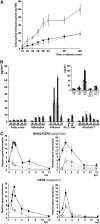A MYB transcription factor regulates very-long-chain fatty acid biosynthesis for activation of the hypersensitive cell death response in Arabidopsis
- PMID: 18326828
- PMCID: PMC2329921
- DOI: 10.1105/tpc.107.054858
A MYB transcription factor regulates very-long-chain fatty acid biosynthesis for activation of the hypersensitive cell death response in Arabidopsis
Abstract
Plant immune responses to pathogen attack include the hypersensitive response (HR), a form of programmed cell death occurring at invasion sites. We previously reported on Arabidopsis thaliana MYB30, a transcription factor that acts as a positive regulator of a cell death pathway conditioning the HR. Here, we show by microarray analyses of Arabidopsis plants misexpressing MYB30 that the genes encoding the four enzymes forming the acyl-coA elongase complex are putative MYB30 targets. The acyl-coA elongase complex synthesizes very-long-chain fatty acids (VLCFAs), and the accumulation of extracellular VLCFA-derived metabolites (leaf epidermal wax components) was affected in MYB30 knockout mutant and overexpressing lines. In the same lines, a lipid extraction procedure allowing high recovery of sphingolipids revealed changes in VLCFA contents that were amplified in response to inoculation. Finally, the exacerbated HR phenotype of MYB30-overexpressing lines was altered by the loss of function of the acyl-ACP thioesterase FATB, which causes severe defects in the supply of fatty acids for VLCFA biosynthesis. Based on these findings, we propose a model in which MYB30 modulates HR via VLCFAs by themselves, or VLCFA derivatives, as cell death messengers in plants.
Figures







References
-
- Balagué, C., Lin, B., Alcon, C., Flottes, G., Malmstrom, S., Kohler, C., Neuhaus, G., Pelletier, G., Gaymard, F., and Roby, D. (2003). HLM1, an essential signaling component in the hypersensitive response, is a member of the cyclic nucleotide-gated channel ion channel family. Plant Cell 15 365–379. - PMC - PubMed
-
- Bligh, E.G., and Dyer, W.J. (1959). A rapid method of total lipid extraction and purification. Can. J. Biochem. Physiol. 37 911–917. - PubMed
Publication types
MeSH terms
Substances
LinkOut - more resources
Full Text Sources
Other Literature Sources
Molecular Biology Databases

